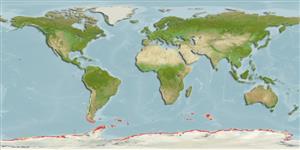Polychaeta |
Phyllodocida |
Polynoidae
Environment: milieu / climate zone / пределы глубины / distribution range
экология
; пределы глубины 8 - 229 m (ссылка 87801). Tropical
Indo-Pacific and the Antarctic. Subtropical to polar.
Length at first maturity / Size / Weight / Возраст
половая зрелость: Lm ? range ? - ? cm
Maximum depth from Ref. 116836. It is commensal with gorgonians and is found at depths of 8 to 200 m (Ref. 87801).
Life cycle and mating behavior
половая зрелость | размножение | нерест | Eggs | Fecundity | Larvae
Members of the class Polychaeta are mostly gonochoric (sexual). Mating: Females produce a pheromone attracting and signalling the males to shed sperm which in turn stimulates females to shed eggs, this behavior is known as swarming. Gametes are spawned through the metanephridia or body wall rupturing (termed as "epitoky", wherein a pelagic, reproductive individual, "epitoke", is formed from a benthic, nonreproductive individual, "atoke"). After fertilization, most eggs become planktonic; although some are retained in the worm tubes or burrowed in jelly masses attached to the tubes (egg brooders). Life Cycle: Eggs develop into trocophore larva, which later metamorph into juvenile stage (body lengthened), and later develop into adults.
Основная ссылка
ссылки | координатор | соавторы
Sicinski, J. and P. Gillet 2002 Biogeographical affinities of polychaetes from Îles Crozet. Antarc. Sci. 14(4):353-363. (ссылка 87389)
Статус Красного Списка МСОП
(ссылка 130435: Version 2025-1)
Статус СИТЕС (ссылка 108899)
Not Evaluated
CMS (ссылка 116361)
Not Evaluated
Угроза для людей
Использование человеком
| FishSource |
инструменты
дополнительная информация
Trophic EcologyFood items (preys)
состав пищи
потребление пищи
хищники
Population dynamicsрост
Max. ages / sizes
Length-weight rel.
Length-length rel.
Размерный состав
Mass conversion
численность
Life cycleразмножениеполовая зрелостьFecundityнерестEggsРазвитие икрыLarvae PhysiologyOxygen consumption
Human RelatedStamps, coins, misc.
ресурсы в Интернет
Estimates based on models
Preferred temperature
(Ref.
115969): -1.9 - 6.9, mean -1.3 (based on 112 cells).
Категория цены
Unknown.
